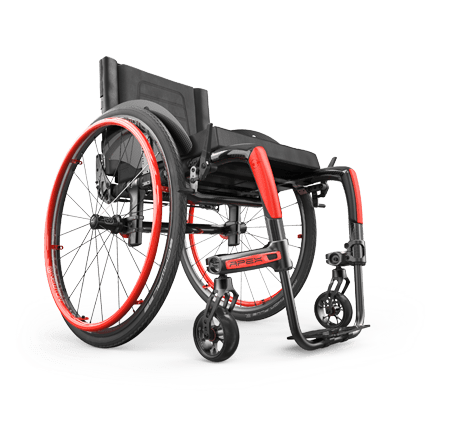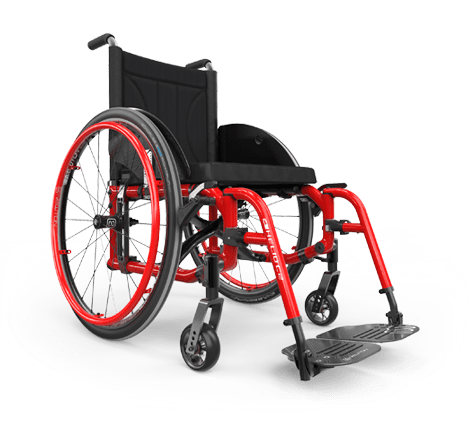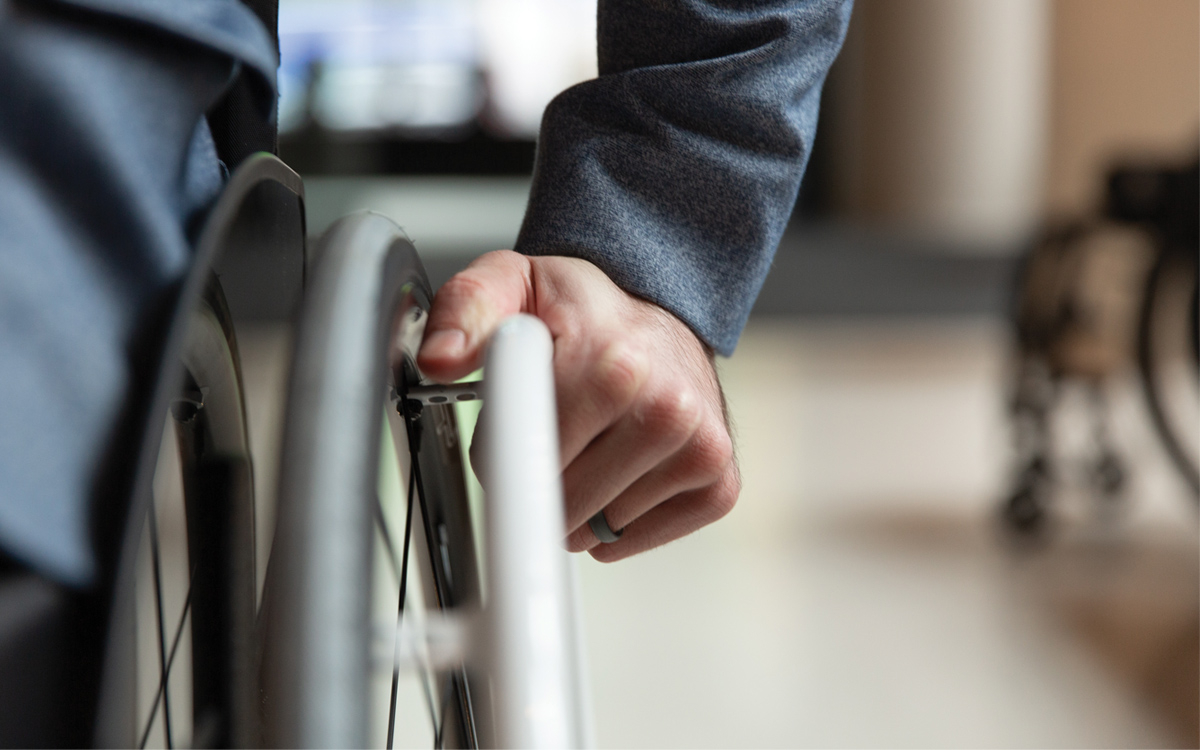As defined by the American Stroke Association, hemiparesis is weakness of one side of the body, whereas hemiplegia is paralysis of one side of the body. The symptoms can be on the same side of the body as the injury or opposite, depending on the part of the nervous system that is affected. A non-exhaustive list of neurological diagnoses that may cause hemiparesis and/or hemiplegia include the following:
- Stroke (CVA)
- Cerebral Palsy (CP)
- Incomplete Spinal Cord Injury
- Brain Injury, Traumatic or Acquired
- Multiple Sclerosis (MS)
- Muscular Dystrophy (MD)
Mobility Limitations & Wheelchair Decisions
Both hemiparesis and hemiplegia can cause varying levels of impairment with balance, walking, speech, or activities of daily living (ADL). They affect pediatrics and adults and can range widely in how they present functionally. When balance or lower extremities are impaired to the extent where an ultralight manual wheelchair is the best option for mobility, there are special considerations you may want to consider when choosing a wheelchair and accessories.
Wheelchair Frame & Weight Considerations
Frame Design
There are two designs of ultralight manual wheelchairs, folding and rigid. Depending on which option you choose, and how each wheelchair is manufactured, they can be more rigid or more flexible in design. Inherently, rigid frame wheelchairs are more rigid and lighter in weight than a folding frame. So, you may be thinking, “lighter weight + more rigid = better propulsion efficiency.” You’re not wrong! But a folding frame also has its advantages. Some may want the folding mechanism for transport, while others, especially in the hemiparetic population, will need to have at least one foot on the ground for propulsion. Having leg rests that can be manipulated out of the way to allow for foot propulsion is not possible on a traditional rigid frame. Here are some details on the folding frame design to look for that can help you distinguish which brand may be your best option!
How the folding mechanism works and how it is constructed are great places to start examining. The industry has typically offered one crossbrace design, and more recently we have started to see a more robust double crossbrace design and even patented technology including the Motion Composites symmetrical crossbrace. The concept with a symmetrical crossbrace is to decrease torsion by allowing more equal weight distribution. The symmetrical design contributes to a ride you would traditionally only feel in a rigid frame, due to decreased energy being lost in the crossbrace from torsional forces with propulsion. You get the benefits of a folding wheelchair for transport and exceptional ride characteristics! Other things that could improve the mechanics of a folding wheelchair would be a larger axle bolt and seat saddles that lock on the inside of the side frame. This will ensure a more responsive wheelchair for better propulsion efficiency. Lastly, make sure you look at the sideframe of a folding wheelchair. Note the shape, how many pieces it is, and how much hardware is required to hold it all together. In general, more pieces equals more hardware, which means more weight and more potential for loosening/movement. You want to make sure that over time, the wheelchair is just as solid as it was the day you got it delivered!
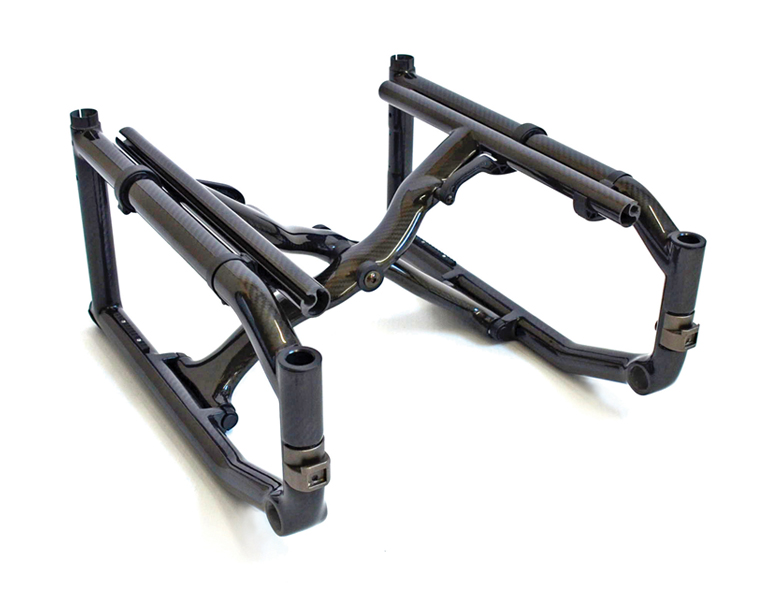
Folding Wheelchair Frame (HELIO C2)
If you decide a rigid wheelchair is right for you and foot propulsion isn’t something you need, there are also key things about the rigid frame to investigate in terms of hemiparesis and hemiplegia. Some rigid frame designs, like the cantilever frame, offer advantages from both ends of the spectrum. This style offers the responsiveness of a rigid wheelchair with flexibility engineered into the shape. Flexibility allows it to disperse road noise away from you. What is road noise? Any bump or vibration that you feel as you’re propelling. Having flexibility engineered into the frame style can allow the wheelchair itself to absorb the vibration instead of it traveling into your body. This can make a significant difference in comfort if you experience neuropathic pain or spasticity.
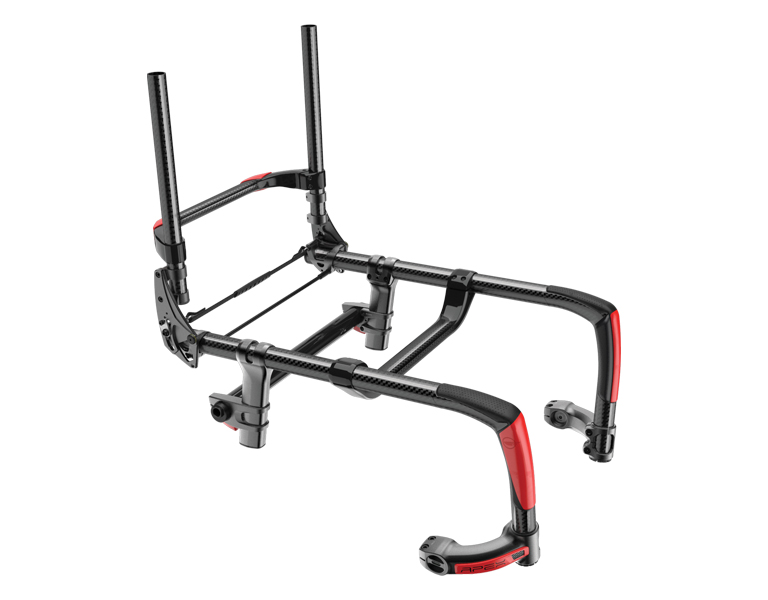
Rigid Wheelchair Frame (APEX C)
Material Characteristics
When people think of high-end materials such as carbon fiber and titanium, they think of their lightweight properties, but that is not the sole reason to choose a higher-end material for your wheelchair. These materials can also have properties such as vibration damping. This means similar to the frame design, the material itself can decrease road noise and decrease your neurological symptoms. Of course, as with frame construction, how the material is engineered and manufactured can affect these characteristics. Don't be afraid to talk to sales representatives and therapists to get these questions answered!
Industry Tip! It is worth noting that many manufacturers advertise their wheelchairs’ transport weight. This weight does not include many of the accessories and options that are necessary for the wheelchair to operate safely with you in it– like rear wheels, wheel locks, and a cushion. Accessories can add up and this can have an impact on independence if you are someone with hemiparesis or hemiplegia! Make sure weight is factored into your decision making (and used in justification!) when selecting the necessary accessories.
Adjustability of the Wheelchair
With neurological impairments, prognosis differs widely across and within diagnoses. For example, in incomplete SCI, most recovery is going to happen in the first 9-12 months, before plateauing after that. Other conditions have different subtypes within the diagnosis such as Muscular Dystrophy and Cerebral Palsy. Each subtype presents its own symptoms and functional deficits. All of this to say, when hemiplegia and hemiparesis are present, there are many variables that play into the mobility equation. Not all days are going to look the same functionally, nor will your abilities as you learn new skills. This makes having adjustability with your mobility device essential.
Rear Axle
A feature that is essential for proper configuration is the ability to move the rear axle in both horizontal and vertical directions. Vertically, you can achieve the proper rear seat-to-floor height for better pelvic alignment and optimal positioning of the upper extremities for propulsion if needed. Horiontal movement allows for optimal center of gravity positioning. The Clinical Practice Guideline for Preservation of the Upper Limb Function Following Spinal Cord Injury states that for optimal configuration, we must “Adjust the rear axle as far forward as possible without compromising the stability of the user.” Over time and with new skill acquisition, you will want to dial-in your unique center of gravity to be the most efficient with propulsion and preserve your upper extremities.
Sideframe Design
How the sideframe of a wheelchair is designed can impact its level of adjustability. Looking for a hybrid between the industry’s standard height and hemi-height frames allows for a larger range of front seat-to-floor heights on a single side frame. This allows your feet to reach the floor and for foot propulsion. But if over time you now need to be pushed by a caregiver or foot propulsion is no longer an option, you keep the same frame and can order a few new parts for the front casters to raise the front height, avoiding an evaluation and costs for a new wheelchair. This saves time, money, energy, and best of all, less downtime for you without a properly configured wheelchair.
Pediatrics
We of course cannot talk adjustability without mentioning pediatrics. Many of the neurological conditions discussed affect children, notably spastic hemiplegia/hemiparesis, a specific type of Cerebral Palsy. Depth adjustability is one of, if not the, most important features that needs to be present on a pediatric wheelchair. Kiddos are going to grow within the “lifetime of the wheelchair,” and it is best practice to be re-configured for optimal use throughout that time.
Options & Accessories for Hemiparesis/Hemiplegia
Once you’ve selected the optimal wheelchair frame for yourself, you can begin to look at options and accessories to customize the wheelchair for your specific needs. Depending on the manufacturer that you choose to get your wheelchair from, they may offer these certain accessories or have them on their order form. However, that does not mean it is always your best option. Accessories can be bought from multiple manufacturers and then later installed on your wheelchair; we refer to this as aftermarket products in the industry. Just make sure each accessory is compatible with your wheelchair. Here we will discuss options/accessories which can be advantageous for those with hemiparesis and hemiplegia.
One Arm Drive
This is a great accessory for single upper extremity propellers, both adults and pediatrics. Pediatrics specifically benefit from this feature due to their shorter limbs and inability to reach the ground for foot propulsion. Without the use of both arms, the one arm drive allows for both straight propulsion and turning to be controlled by one wheel. Two handrims are placed on the dominant side while a mechanism is installed under the wheelchair to allow for a second handrim to control the non-dominant side’s wheel. If both handrims are grasped and pushed forward, you will move straight. If you grab one of the handrims or the other, you will turn. This does require the ability to manipulate and grasp both handrims at once for successful propulsion. Make sure you look up different manufacturer models and potentially trial a couple of options to see what works best for you!
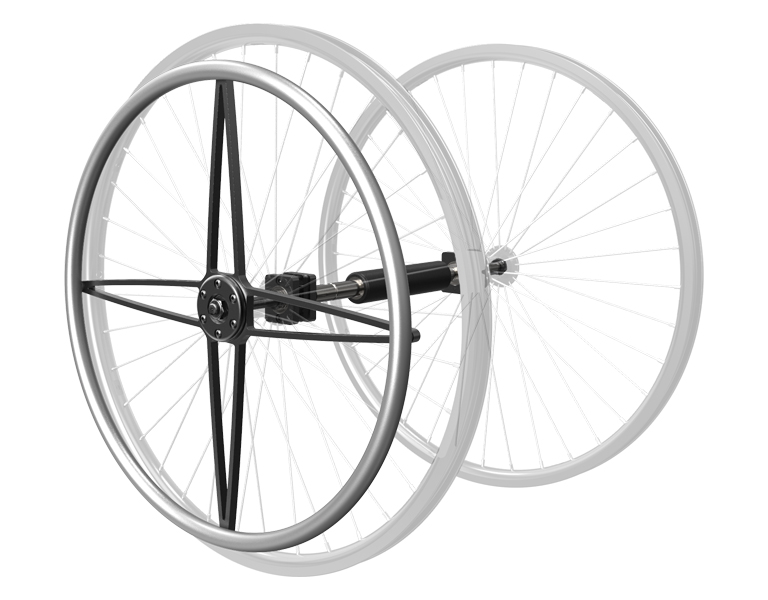
One Arm Drive
Wheel Lock Extension Handle
A wheel lock extension handle for the non-dominant side is a great, low-cost option to be able to reach and lock both sides of the wheelchair with the dominant upper extremity. The extension gives that extra length for easier access. It is a simpler and less expensive alternative to a unilateral wheel lock if funding is limited.
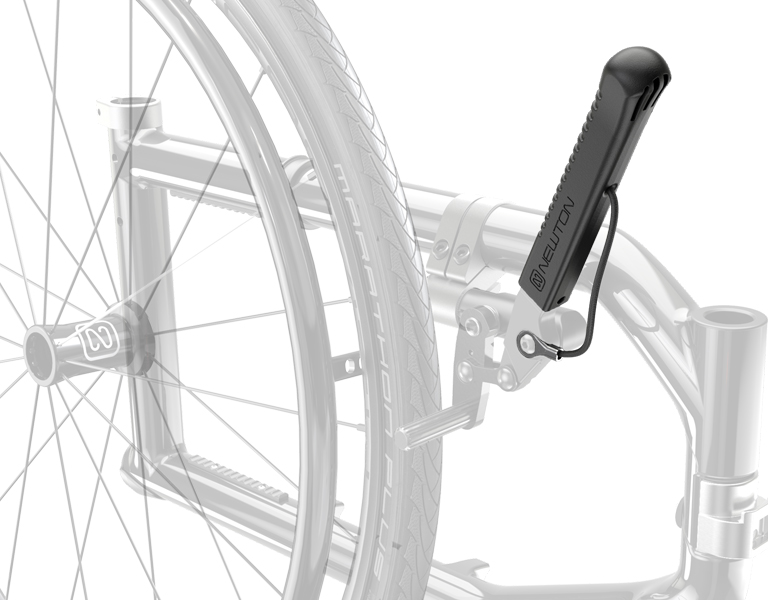
Newton Wheel Lock Extension Handle
Unilateral Wheel Lock
If a wheel lock extension handle is not an option, a unilateral wheel lock may be the way to go! This accessory allows you to lock both wheels using one lock. It can be mounted on either side, depending on your handedness. The double cable mechanism is designed to be easily folded up while the wheelchair is in transport but can also be mounted on a rigid frame. Some manufacturers have these as options on their order forms, but they can always be added on to your wheelchair as an aftermarket purchase from another manufacturer. Always triple check that the accessory will fit on your wheelchair model.
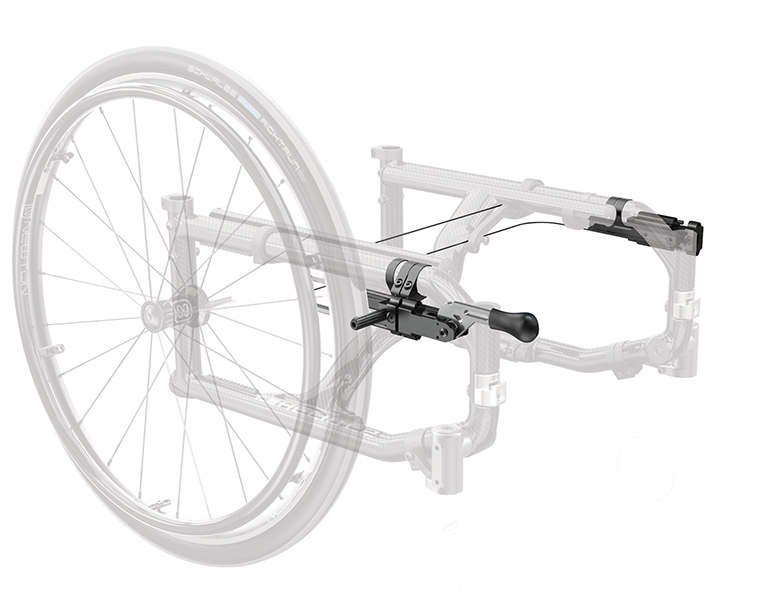
Unilateral Wheel Lock (Learn more)
Arm Trough/Trays
So much of a therapist’s mindset is getting a hemiparetic patient back to their prior level of function. However, positioning and handling of the weak side is very important for those 23 hours when you’re not in therapy. Having proper support of the shoulder, elbow, and wrist in a seated position is imperative to avoid pain, contracture, and other musculoskeletal impairments. It is very important that your therapist/team provides education to you and your support system about proper positioning for upper extremity preservation. An arm trough or a tray are helpful accessories that can be added onto an armrest to better support your weaker side, protecting it from tight corners/doorways, and can help avoid the arm from slipping off the armrest. Always check the skin under your elbow and any area of the arm that is in contact with the surface to make sure there are no red areas of concern, especially if you have decreased or absent sensation.
Having every single accessory and the highest-end material is not always a reality. Some of those mentioned you may not need, and others may be limited by funding. Knowing what manufacturers offer and which products are more adjustable, and durable is crucial in decision making. In the end, it is important to determine your unique needs with hemiparesis/hemiplegia and prioritize them for the wheelchair evaluation process.
References
1. Stoke.org. (n.d.). Hemiparesis: Physical Impact. Retrieved from https://www.stroke.org/en/about-stroke/effects-of-stroke/physical-effects-of-stroke/physical-impact/hemiparesis
2. Anthony S. Burns, Ralph J. Marino, Adam E. Flanders, Heather Flett, Chapter 3 - Clinical diagnosis and prognosis following spinal cord injury, Editor(s): Joost Verhaagen, John W. McDonald, Handbook of Clinical Neurology, Elsevier, Volume 109,2012, Pages 47-62, ISSN 0072-9752, ISBN 9780444521378, https://doi.org/10.1016/B978-0-444-52137-8.00003-6.
3. Paralyzed Veterans of America Consortium for Spinal Cord Medicine (2005). Preservation of upper limb function following spinal cord injury: a clinical practice guideline for health-care professionals. The journal of spinal cord medicine, 28(5), 434–470. https://doi.org/10.1080/10790268.2005.11753844.




